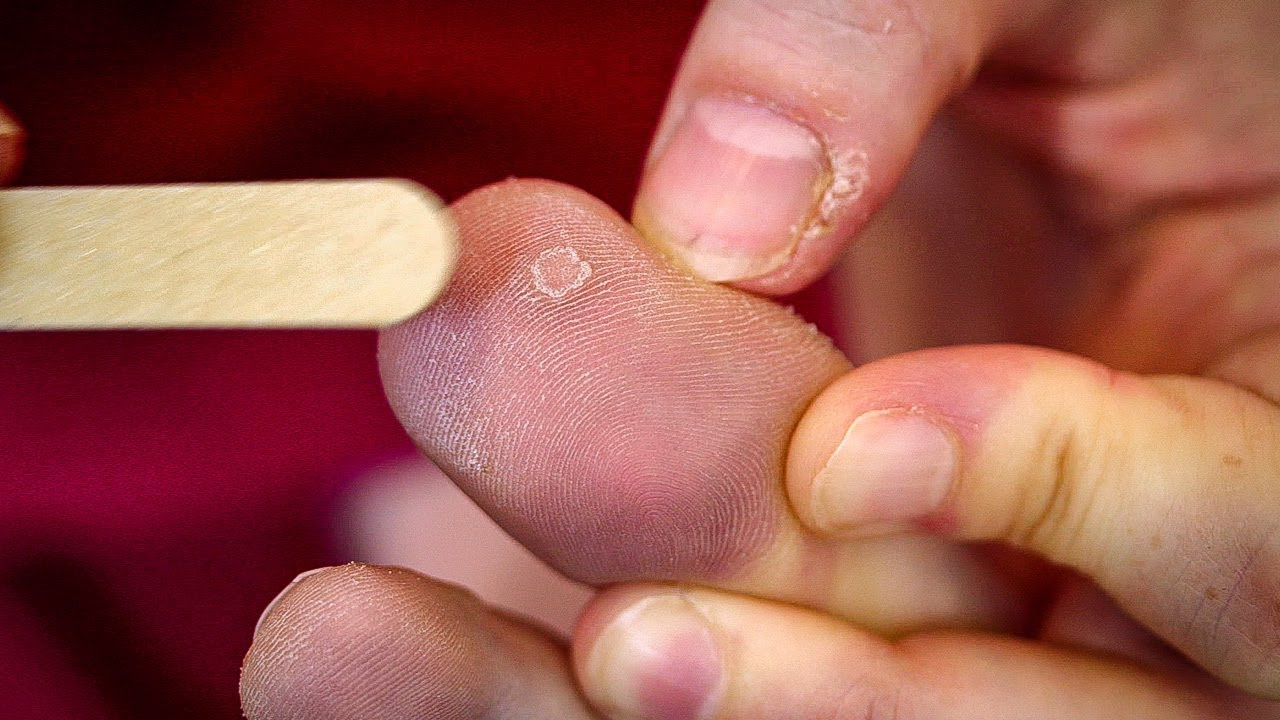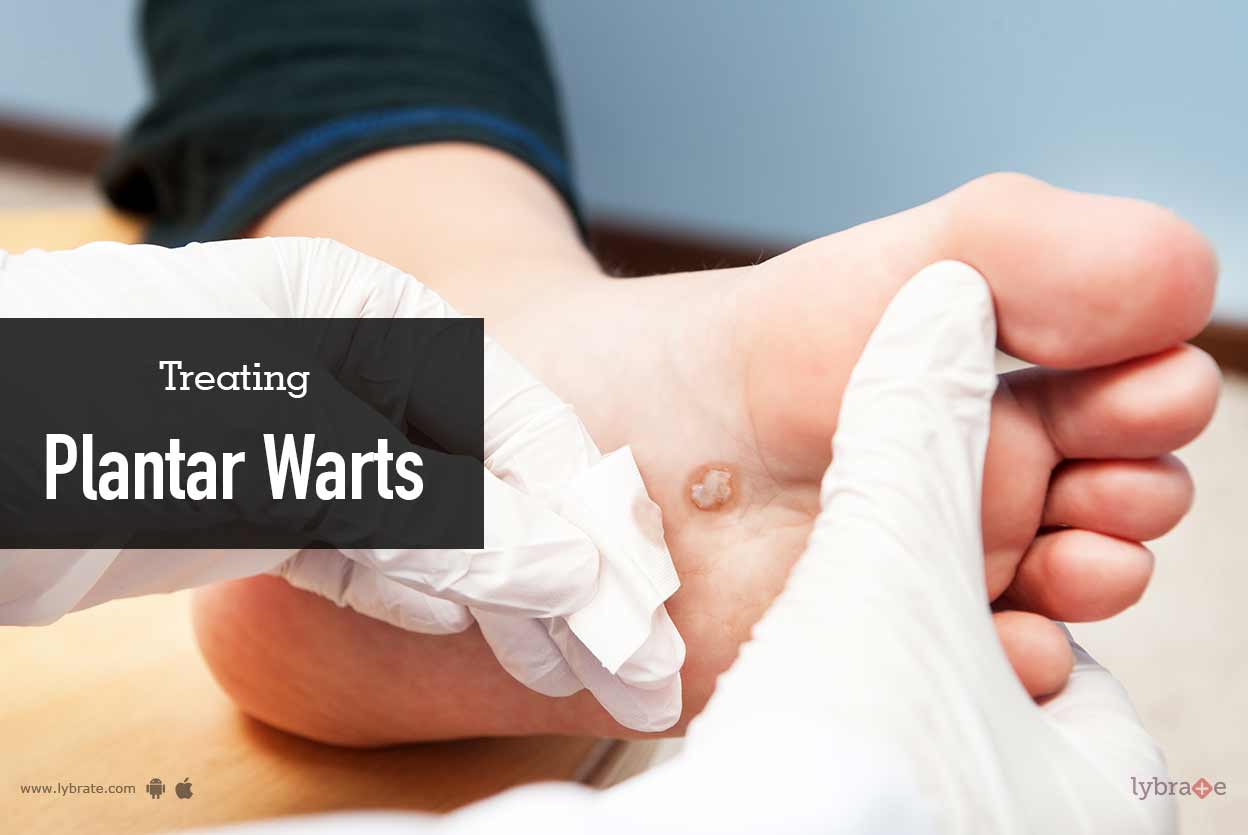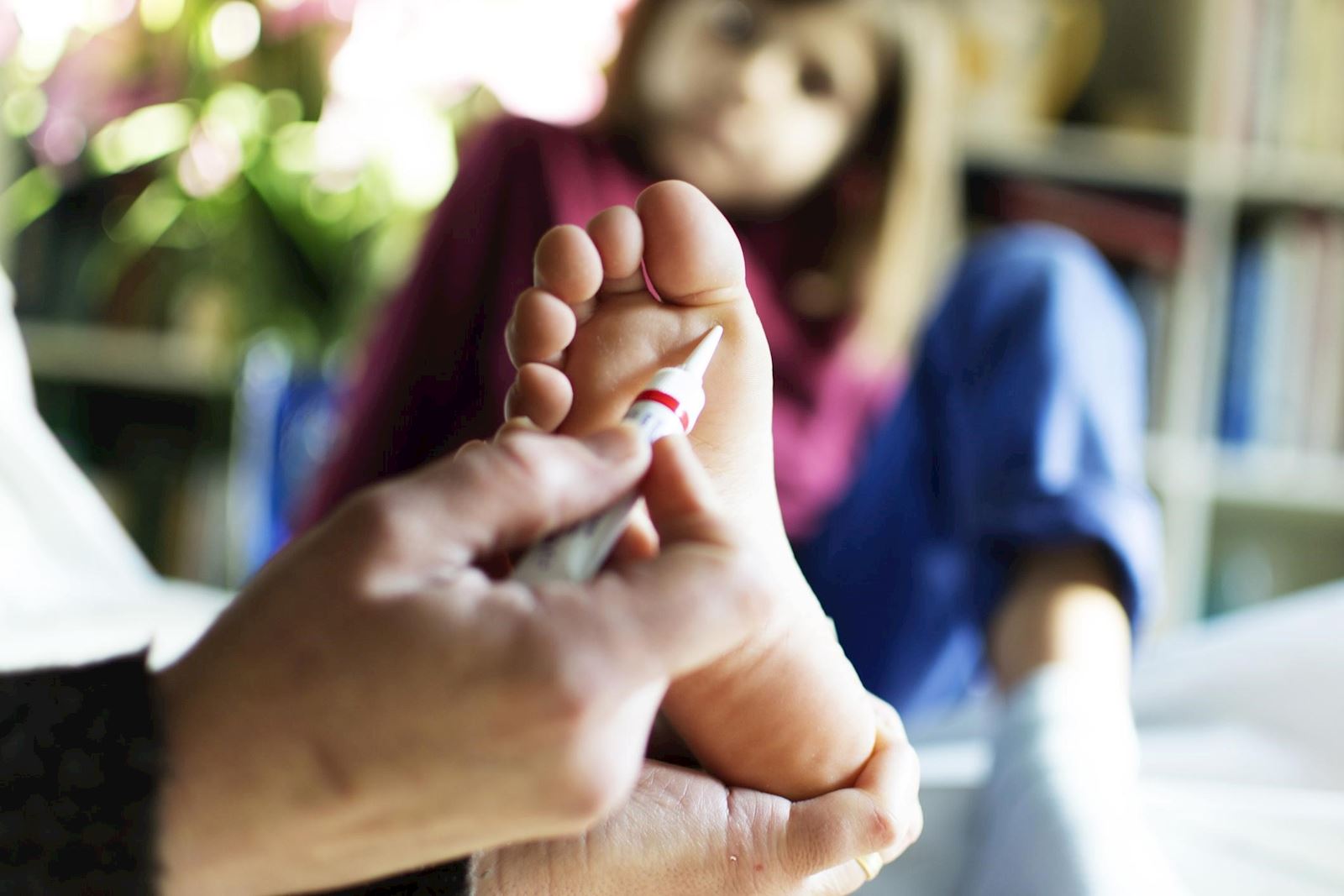A. Plantar Warts and Palmar Warts
Plantar and palmar warts are common, especially in children. These warts have the name of where they appear on the body. Palmar warts occur on the hands, and plantar warts occur on the lower part of the feet.
Practically everyone has a wart (or several) at some point in their life.
1. What are plantar warts and palmar verrucas?
Plantar and palmar warts are non-cancerous warts caused by a viral infection in the upper layer of the skin. The culprit is a viral strain called human papillomavirus or HPV. There are many strains of the virus, and those that cause common warts on the hands and feet are not the same HPV strains that cause genital warts.
Some people mistakenly think that plantar or palmar warts are malignant. In fact, they are not harmful. Eventually, most warts disappear after about two years without treatment. However, warts can cause slight irritation or pain, depending on their location.
2. What are plantar and palmar warts like?
On average, plantar and palmar warts are small, approximately the size of an eraser. But some warts grow more. Sometimes plantar warts grow in clusters; these are called mosaic warts.
Sometimes the calluses or calluses are mistaken for a palmar or plantar wart. Small black spots appear on some warts, leading them to be called “seed warts”. In reality, black spots are small blood vessels that have become the wart. Warts do not really have “seeds”.
Plantar warts usually do not stand out as much from the skin as hand warts, due in part to walking pressure and their flattened effect.
3. How do you get a plantar wart or a palmar wart?
Warts are transmitted from person to person. Transmission can be indirect. For example, a child with a wart in his hand may touch a play surface, which is then touched by another child, and the wart spreads. Or a person with a plantar wart uses a shower without wearing bath shoes, and another person then wears them and develops a wart. The risk of getting a wart on someone else’s hands or feet is small.
The risk of a person getting a wart varies. People with weakened immune systems are more susceptible. However, people with healthy immune systems can also develop warts.
4. What are treatments for plantar and palmar warts?
Plantar and palmar warts often disappear on their own without treatment. However, if they bother you, you can treat common skin warts in several ways.
- The duct tape is a home remedy. Stick a small strip over the wart and leave it on for six days. Then remove the tape, dip the wart in water, and then gently remove it with a pumice or Emory board. Repeat this process as many times as necessary until the wart disappears. This may take a couple of months. Do not expect miracles from this type of treatment, as it is unlikely to work better than a placebo.
- Over-the-counter treatments include medicines that are applied topically (gel, ointment, lotion) and usually contain salicylic acid, which works by peeling the wart. Another option is a freezing spray that kills the tissue. These medicines work about 50% of the time.
- Medical treatments are generally more effective. They include freezing the wart with liquid nitrogen, removing it with a laser or surgery, or using or injecting medicines to boost your immune system so it can rid your body of the virus.
However, treatment is not quick and easy. For example, treating hand warts at home can take from a few weeks to a few months. Plantar warts are more difficult to treat because most of the wart is below the skin surface.
B. 6 home remedies for plantar warts
We include products that we think will be useful for our readers. If you buy through links on this page, we can earn a small commission. Here is our process.
Warts are a non-carcinogenic lesion that can grow on the skin of both children and adults. Warts are spread through skin to skin contact. Plantar warts are a type of wart that grows on the bottom of the foot.
Plantar warts can disappear without treatment, but some safe and effective home remedies can accelerate the healing process.
In this article we present several home remedies for plantar warts.
1. Salicylic acid
- Many over-the-counter products used to treat warts contain salicylic acid as the main ingredient. Salicylic acid for the treatment of warts and verrucas is available as a gel, liquid or pillow.
- According to the AAD, you should dip the wart in hot water before applying the salicylic acid once a day. Sometimes the healthy skin surrounding the wart can become painful or painful.
- In this case, the AAD recommends temporarily stopping the treatment and resuming it after a few days. Warts take weeks to disappear, even with effective therapy, so stopping the treatment for a short period of time will not significantly affect the time needed for the wart to disappear.
2. Adhesive tape
- The application of adhesive tape to warts is a convenient and inexpensive treatment.
- The DAA recommends changing the tape every few days, which can cause the top layer of the wart skin to detach. After repeated use, the wart can eventually peel off.
- However, studies have not confirmed the effectiveness of this home remedy. A 2020 study published in Dermatologic Therapy magazine showed that traditional cryotherapy or freezing in a dermatologist’s office was more effective than tape therapy. However, the study suggests that tape therapy appears to be safe and may be effective in certain circumstances.
3. Home freezing spray
- Another product that is available on the counter is the freezing spray for warts.
- Manufacturers declare that the freezing spray gels the wart in a way similar to cryotherapy. However, cryotherapy uses much cooler temperatures to destroy the wart.
- According to older research from 2006, doctors use liquid nitrogen at a temperature of -196°C.
- Pharmaceutical freezing sprays can only freeze the skin at -70°C and do not work as quickly as liquid nitrogen.
- People may need longer treatment times with home freezing sprays. Even after cryotherapy, it can take several months to see improvements.
4. Tea tree oil
Some people use tea tree oil on warts and other skin infections.
- An older study published in 2008 in Complementary Therapies in Clinical Practice reported a case of successful treatment of warts on a child’s finger with tea tree oil.
- In this study, the lesions were treated with tea tree oil once a day for 12 days. The wart disappeared, and researchers reported that the affected area was completely healed after 12 days.
- It is uncertain whether this treatment is effective for plantar warts. There is not enough investigation to prove the effectiveness of tea tree oil in removing plantar warts.
- Note that tea tree oil is available in different strengths. Some can be applied directly on the skin, while others need to be diluted in a carrier oil. Follow the manufacturer’s instructions.
5. Iodine
- A 2015 study published in the journal Dermatology and Therapy reported the effectiveness of a 2% topical iodine-povidone solution for the treatment of common warts.
- Doctors and other healthcare professionals can use iodine supplements to clean a person’s skin before surgery or other procedures that break the skin barrier.
- The preparation that the researchers used in this study contained iodine, but added other ingredients that are not available in pharmacies.
- Although the results have been promising, there is insufficient research to confirm the efficacy of OTC iodine in treating plantar warts.
6. Zijinding
- Zijinding is a Chinese herbal remedy for plantar warts. A study published in the Journal of Cosmetic Dermatology identified three case reports of successful treatment for plantar warts with Zijinding paste made with white vinegar.
- The three participants used the Zijinding preparation on their plantar warts for 1.5 to 5 months. The researchers reported a significant clinical response and no relapse for at least 10 months after stopping treatment.
Plantar warts are a common condition. A person can transmit HPV infection through contact with the skin. To avoid plantar warts, people should avoid walking barefoot in public, especially in swimming pools, gyms and changing rooms.
Although some plantar warts may disappear without treatment, some home remedies can help cure warts, such as salicylic acid. Other home remedies may work, but there is not enough research to confirm that the other remedies are effective.
C. How to Treat Plantar Warts at Home Naturally
These types of warts can be painful and the resulting raised lumps are uncomfortable. Plantar warts also have “wart seeds” or tiny black spots that are actually blood vessels. Although plantar warts are not necessarily harmful, they can grow and make you stand and walk uncomfortable.
It is possible to treat plantar warts at home, but knowing when to see a doctor for medical treatment is also important.
1. Home plantar wart treatment
Plantar warts, although not dangerous, should be removed for reasons of discomfort and aesthetics. According to the American Academy of Dermatology, any treatment to remove warts will take several weeks, if not more.
a. Salicylic acid
Salicylic acid is a type of beta-hydroxy acid commonly used to treat acne. It removes dead skin cells that can sometimes clog pores.
Higher concentrations of salicylic acid can be found in over-the-counter warts (OTC) creams and ointments. These products gradually peel the skin around the wart until it is completely eliminated.
To get the most out of this treatment, you need to apply salicylic acid to the plantar warts twice a day. It can also help prepare the skin by dipping the affected area in warm water for 10 minutes before applying the acid.
It may take several weeks for the warts to completely disappear.
b. Scotch tape
One way to gradually get rid of plantar warts is to use tape. Place a small piece of tape on the affected area and change the tape at least twice a day. (You may need to change the tape more often if you have warts on the soles of your feet.)
The idea behind the wart tape is that it can help to peel off the layers of the warts. In theory, the wart will eventually come off completely.
c. Apple vinegar
Apple cider vinegar continues to be studied for a variety of health uses, including the possible removal of warts. A 2006 study, Trusted Source, suggests that vinegar’s anti-infective properties may help reduce plantar warts. However, more research is needed to support this.
To use apple cider vinegar on your warts, apply a cotton ball to the affected area twice a day.
d. Tea tree oil
Tea tree oil has been used as a topical antiseptic in the past. It is mainly used for yeast infections, wounds and acne. Although not widely used, tea tree oil can also act on plantar warts.
To try this remedy, apply a small amount of tea tree oil diluted with olive or almond oil to the affected area twice a day.
e. Milk Thistle
Milk thistle is another herbal remedy that can help get rid of skin diseases. In contrast to tea tree oil, milk thistle has been studied for its antiviral properties. You can apply diluted milk thistle extract to your warts twice a day.
Do not use this product if you have a history of allergy to ragweed.
f. Iodine
Iodine is an essential mineral most commonly associated with thyroid health. However, certain formulations can also be used for other purposes – this includes removing warts.
A Trusted Source study found that a combination product made from a topical solution of providone-iodine helped to clear up warts after use twice a day for a period of 12 weeks. You can buy both products at a pharmacy.
However, this type of treatment is best used under medical supervision, especially if you have underlying chronic illnesses, such as thyroid disease.
g. OTC freezer sprays
In addition to salicylic acid, you can also buy “freezing sprays” for plantar warts at the pharmacy. These products containing liquid nitrogen are designed to mimic the effects of cryotherapy in a doctor’s office.
The spray creates a blister-like lesion that sticks to the wart. As soon as the blister heals, the wart will also go away.
To use the freezer spray, apply the product directly to the wart for up to 20 seconds. Repeat if necessary. The bubble forms and falls in about a week. After that time, if the wart is still there, you can repeat the treatment.
2. Wart or callus plant?
- Calluses are caused by repeated friction against the skin. They occur most frequently on the hands and feet. With a callus, you can notice a raised area of skin that is white in color.
- Calluses are not the same as plantar warts. Sometimes the two look similar, except that the calluses have no black patches.
- Calluses can disappear on their own when the friction against the skin stops, just like when you change tight shoes for a better fitting pair. The outer skin of the callus can also be cut or filed.
- It is possible to have plantar warts inside a callus. This is because the increased friction caused by the callus also increases the risk of obtaining this type of warts, according to the Mayo Clinic.
A plantar wart that grows inside can also cause a callus due to the increased pressure on the skin.
3. Risk factors for plantar warts
Although plantar warts are caused by the HPV virus, there are other risk factors to consider. If you have an increased risk of getting plantar warts:
- You have a history of plantar warts
- They are a child or a teenager
- Have a weak immune system
- Walk barefoot frequently, especially in areas prone to germs, such as changing rooms
4. Prevention of Warts Planting
With the proper precautions, you can avoid plantar warts, even if you are at increased risk of developing them:
- Avoid touching the warts, including your own warts.
- Wash your hands before and after touching a wart.
- Do not pick up a wart with your fingers.
- Do not use the files and pumice stones you used on areas of affected skin on unaffected areas.
- Do not walk barefoot in public areas.
- Keep your feet clean and dry.
- Change your socks and shoes frequently.
5. When consulting a doctor
Plantar warts that do not disappear or continue to return despite treatment at home should be examined by a doctor. This doctor can treat the warts in the doctor’s office with cryotherapy. The doctor may also recommend prescription foot creams to get rid of warts and verrucas for good.
For chronic plantar warts, your doctor can refer you to a podiatrist.
You may want to refrain from treatment at home and consult your doctor immediately if you wish:
- Diabetes
- A generally weakened immune system
- HIV or AIDS
- Massive brown or black warts (these can be cancerous)
- Plantar warts that change color or size
- Serious discomfort caused by warts
- Changes in gait pattern
6. Takeaway
Plantar warts tend to disappear over time, and it may be possible to treat them at home.
If in doubt, always seek the advice of a doctor, especially if the warts are getting worse or affecting your daily mobility.











